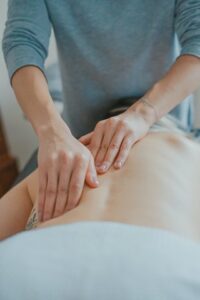 One of the most hindering feelings one can have is the restriction of persistent low back pain. Often felt as a stiff, almost locked-in place hip, which really isn’t the hip at all but the sacroiliac joint (SIJ) of the pelvis, the feeling that one just needs to “pop” things into place and they will release and ease up. The worst part of this condition is that, for the sufferer, it feels as if it might release, and so he or she will try everything possible to make that release happen. The problem is that it rarely releases in response to the self-manipulation but feels worse over time.
One of the most hindering feelings one can have is the restriction of persistent low back pain. Often felt as a stiff, almost locked-in place hip, which really isn’t the hip at all but the sacroiliac joint (SIJ) of the pelvis, the feeling that one just needs to “pop” things into place and they will release and ease up. The worst part of this condition is that, for the sufferer, it feels as if it might release, and so he or she will try everything possible to make that release happen. The problem is that it rarely releases in response to the self-manipulation but feels worse over time.
That’s the most common presentation into my office: A person who has developed this type of pain and has tried to tough it out, only to find him or herself progressively worsening in an unrelenting situation. The typical sufferer of this type of back pain is usually functionally mobile – that is, under normal circumstances they move about freely with minimal to no pain. All body-types can get this type of pain, whether petite, muscular or overweight. Their generally good mobility is the reason they believe they can work things out with a little poking, prodding, rolling, rubbing, and stretching. Less functionally mobile people – elderly, disabled, and/or obese – tend to have more generalized and chronic pain, that is, hurting in many places constantly. It is not that they may not feel the symptoms described above, they are just less likely to try and take care of it on their own. What I am describing in this piece is the almost always self-worsened low back pain and stiffness that needs professional attention but which is delayed.
 The first thing to address in this condition is any fixated joints within the spine or pelvis (stuck joints). The restrictions can be in one or more structures – from the lumbar spine to the sacrum to the SIJs – contributing to the feeling of stiffness. This is what the sufferer is trying to release, to twist or stretch just enough to elicit a “pop”. Unfortunately, fixated joints in the low back are the most difficult to move – they are a challenge for many practitioners let alone a layperson trying to do it on themselves. What results from the sufferer’s endeavors is a reflexive guarding response – a sort-of rebound contraction and stiffening to prevent any further insult to the joint. It is this rebound muscle spasticity that increases the level of pain. When it has been present for several days, the sufferer usually seeks help.
The first thing to address in this condition is any fixated joints within the spine or pelvis (stuck joints). The restrictions can be in one or more structures – from the lumbar spine to the sacrum to the SIJs – contributing to the feeling of stiffness. This is what the sufferer is trying to release, to twist or stretch just enough to elicit a “pop”. Unfortunately, fixated joints in the low back are the most difficult to move – they are a challenge for many practitioners let alone a layperson trying to do it on themselves. What results from the sufferer’s endeavors is a reflexive guarding response – a sort-of rebound contraction and stiffening to prevent any further insult to the joint. It is this rebound muscle spasticity that increases the level of pain. When it has been present for several days, the sufferer usually seeks help.
I can almost guarantee a stuck joint is present in this condition. Even if not so in the beginning of the symptoms, most surely after the regions have been poked and pulled, stretched and twisted, and rolled over by balls or foam cylinders, one or more joints are fixated. The biggest danger from not getting the joint fixation corrected is what can ultimately develop: degeneration, arthritis and radiculopathy (pain and tingling down a leg). The longer a stuck joint is allowed to persist, the greater the physiological changes leading to a more chronic condition.
Chiropractic is a very specific art and practice; it cannot be replicated by non-chiropractors, regardless of their degrees. Chiropractors have studied years to learn their art – there are no non-chiropractic disciplines that match the chiropractors training. Simple mobilization, which is the most common non-chiropractic “popping” of joints, is not the specific traditional chiropractic adjustment which leads to healing. Knowing the location of actual fixation is paramount is correcting this issue and bringing pain relief. A general mobilization will often make the problem worse, albeit not as bad as the self-administered attempts to pop oneself into place.
Additionally, a number of muscles also play a significant part in the pain syndrome, so if the sufferer only gets adjusted, and not the appropriate muscle work as well, then the results are usually diminished and short-lived. Many muscles can be involved including the hip flexors and piriformis. For people who rarely stretch, the need to have some continuation of care beyond the initial visit will be necessary to prevent a cyclic recurrence of pain and stiffness. You will always help your case by stretching as soon as possible. Knowing which muscles to stretch is equally important; I cannot stress enough the importance of learning the proper stretches for the muscles which are tight on you. Very often a strengthening routine is also necessary.
 So that leads to the next question: How long until I am better? Well it depends. More functionally mobile people – that is, people who stretch, people who exercise regularly, and people who aren’t hampered by excess weight or other injury – will have the fastest recovery. The less having to be done by the practitioner, the more that can be done at home. But time and repetition is often needed to retrain the joints, ligaments and muscles surrounding the joint. The upside is that once you learn which joints are fixated and work toward bringing flexibility and strength to that region, it will likely be more mobile and sturdier than ever.
So that leads to the next question: How long until I am better? Well it depends. More functionally mobile people – that is, people who stretch, people who exercise regularly, and people who aren’t hampered by excess weight or other injury – will have the fastest recovery. The less having to be done by the practitioner, the more that can be done at home. But time and repetition is often needed to retrain the joints, ligaments and muscles surrounding the joint. The upside is that once you learn which joints are fixated and work toward bringing flexibility and strength to that region, it will likely be more mobile and sturdier than ever.
Don’t allow yourself to suffer under the illusion that your pain will just go away on its own. Get quick, immediate care and then work toward a long term solution, so that you don’t establish a circular progression into pain, degeneration, adaptation and pain again. If you are in Beverly Hills, Los Angeles, or West Hollywood and need chiropractic relief, call my office. Nip things in the bud, so to speak, and address your lingering low back pain today so you don’t have to suffer a painful tomorrow.

